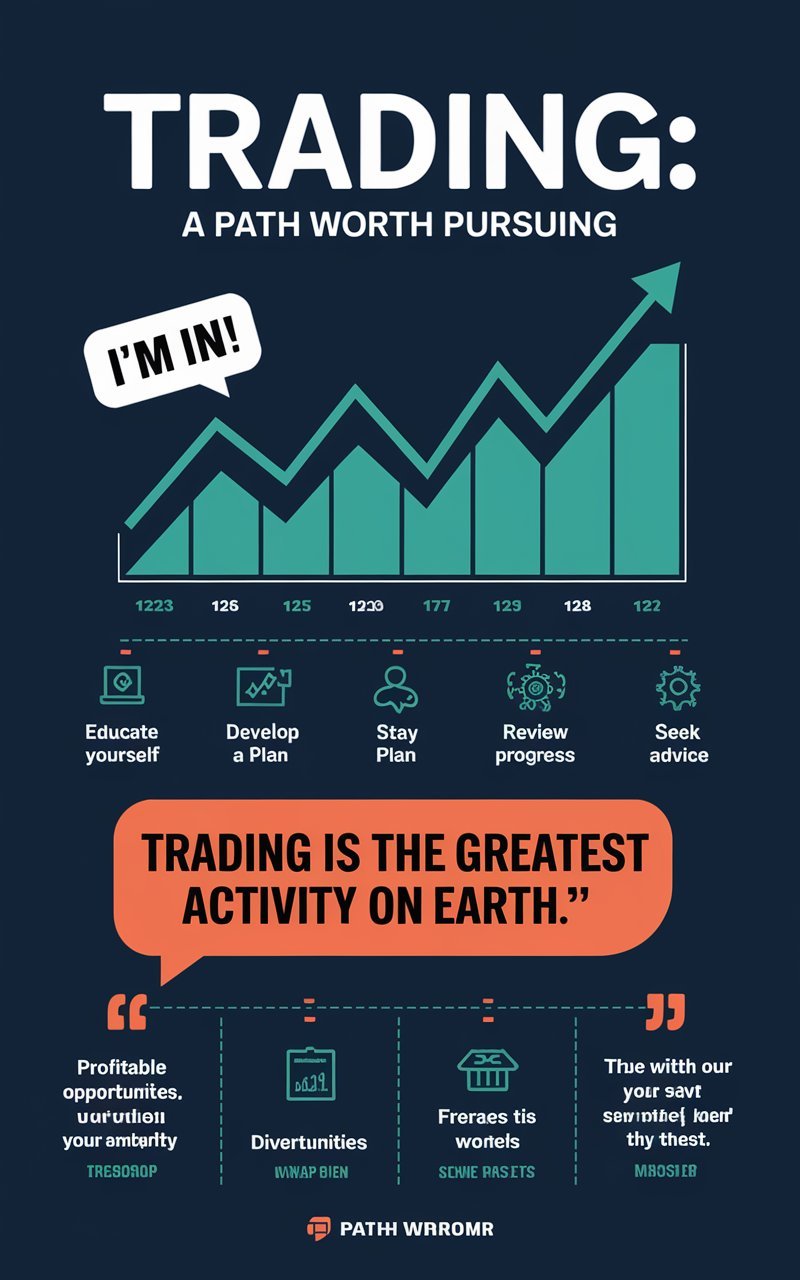Trading is the art of buying and selling financial instruments—stocks, currencies, commodities, or derivatives—to profit from price movements. While it appears simple on the surface (buy low, sell high), the reality is starkly different. Trading is a psychological battleground where 95% of success hinges on mindset, discipline, and emotional control—and only 5% on technical skills. This article dismantles the myths, exposes the challenges, and reveals whether anyone can truly succeed as a trader.
Trading is more than just a financial activity; it’s a test of skill, discipline, and emotional resilience. Success in trading isn’t handed out—it’s earned through consistent effort, strategic thinking, and relentless practice.
If you’re considering stepping into the world of trading, it’s important to understand this: trading isn’t a casual hobby. It’s not a game where luck trumps experience or where beginners stumble into victories over seasoned professionals. Trading is like any performance-based craft. Whether in sports, music, or the arts, it rewards those who treat it with respect. It requires preparation and a professional mindset.
Let’s explore what trading truly entails and why adopting a professional approach is essential to your success.
Trading: A Skill Built Through Mastery and Dedication
Trading is a performance-based activity in every sense. To succeed, traders must hone their craft with the same dedication as elite athletes or masterful artists. It requires agility in rapidly changing conditions, discipline in execution, and an unwavering focus on long-term goals.
Here’s the truth: amateurs occasionally profit by sheer luck. But consistent success is reserved for those who treat trading as both an art and a science. Professionals rely on routines and strategies they’ve refined over time, leaving no room for guesswork.
Why is this critical?
Because trading is a business—one that demands structure, precision, and calculated decisions. Small mistakes that amateurs brush aside can lead to significant losses. Professionals know this and take every measure to mitigate risk and maximize their edge.
The Illusion of Simplicity: Why Trading Feels Easy
Trading platforms, flashy ads, and “get-rich-quick” gurus paint a deceptive picture:
- Accessibility: Open an account in minutes, trade with a few clicks.
- Low Barriers: No formal education or certifications required.
- Survivorship Bias: Social media highlights only winners, masking the 98%+ who fail.
The Reality: Trading is like learning brain surgery by watching YouTube tutorials. The mechanics are simple; mastery is not.

Why Most Traders Lose Money
Studies reveal sobering truths:
- 80–90% of day traders quit within 2 years (FINRA, 2024).
- 72% lose money consistently (University of California Study).
Key Reasons for Failure:
- Poor Risk Management: Betting too much on single trades.
- Emotional Decision-Making: Fear, greed, and revenge trading.
- Lack of a System: Chasing trends without a tested strategy.
- Overconfidence: Misinterpreting luck as skill.

The 95% Psychology Rule: Trading’s Hidden Core
Warren Buffett once said, “Investing is not a game where the guy with the 160 IQ beats the guy with the 130 IQ. Once you have ordinary intelligence, what you need is the temperament to control the urges that get other people into trouble.”
Psychological Traps to Conquer:
- Fear of Missing Out (FOMO): Jumping into trades late.
- Loss Aversion: Holding losers hoping they’ll rebound.
- Overconfidence: Ignoring stop-losses after a winning streak.
- Impatience: Abandoning a strategy too soon.
Actionable Fix:
- Keep a trading journal to track emotional triggers.
- Meditate for 10 minutes daily to improve mental clarity.
- Use automated tools (stop-losses, take-profits) to enforce discipline.
The 5% Technical Edge: What You Actually Need to Know
Technical skills matter, but they’re secondary to mindset. Focus on:
- Risk-Reward Ratios: Aim for 1:2 or better (risk 1tomake1tomake2).
- Position Sizing: Never risk more than 1–2% of capital per trade.
- Basic Technical Analysis: Support/resistance, moving averages, RSI.
- Market Hours: Trade during high-liquidity sessions (e.g., NY/London overlap).
Example: A swing trader using a 50-day moving average crossover strategy risks 1% per trade and exits at 3% profit or 1% loss.

Can Anyone Become a Trader? Yes, But…
Trading is a skill, not a talent. However, success requires:
- Self-Awareness: Recognize your emotional weaknesses.
- Discipline: Follow your plan even when it hurts.
- Resilience: Learn from losses without quitting.
- Continuous Learning: Adapt to changing markets.
Who Fails: Those seeking quick riches, shortcuts, or refusing to accept responsibility for losses.
Who Succeeds: Patient, process-oriented individuals who treat trading like a business.
The Reality of Success in Trading
So, can anyone become a successful trader? The answer is yes—but only if you’re willing to approach trading with a professional mindset. This isn’t a get-rich-quick scheme. Success requires grit, dedication, and relentless practice.
Professionals thrive because they view trading as a journey, not a destination. They embrace every setback as a chance to grow. Every gain serves as validation of their effort. Every decision is an opportunity to refine their craft.
How to Start (and Survive): A 6-Step Roadmap
- Educate Yourself: Study risk management first—books like Trading in the Zone (Mark Douglas).
- Choose a Niche: Forex, stocks, crypto? Master one market.
- Develop a Strategy: Backtest it on 5+ years of data.
- Trade Demo for 3–6 Months: Prove consistency before using real money.
- Start Small: Risk 10–10–20 per trade initially.
- Review Weekly: Fix one mistake at a time.
The Edge Professionals Cultivate
In trading, experience matters. A seasoned tennis player can outplay a beginner with years of practice and preparation. Similarly, experienced traders outperform newcomers. They have developed what’s called an edge.
An edge is an advantage—born from countless hours of study and execution—that tilts the odds in their favor. Professionals cultivate their edge through:
- In-depth market knowledge
- Refined trading strategies
- Strict risk management
- Unshakable emotional discipline
By mastering these elements, professionals transform trading from a gamble into a calculated pursuit. Their success is no accident; it’s the result of deliberate effort and commitment.
The Trap of Amateur Trading
Many retail traders enter the market full of excitement, chasing dreams of quick riches. But here’s the harsh reality: the market doesn’t forgive shortcuts.
Amateurs often fall into traps like:
- Jumping between strategies
- Trading on emotions
- Over-leveraging positions
- Failing to manage risk effectively
These missteps aren’t just costly—they’re why so many traders give up. Trading demands focus, preparation, and the ability to learn from failure. Emotional responses, overconfidence, and a lack of strategy are the quickest paths to financial losses.
Key Principles for Professional Trading
If you’re serious about trading, you need to think and act like a professional. Here are the foundational principles that can transform your trading journey:
1. Develop a Clear Strategy
A solid trading plan is your foundation. Define your entry points, exit targets, and acceptable risk for each trade. Having a clear roadmap prevents impulsive decisions and keeps you grounded during market volatility.
2. Master Risk Management
Risk management isn’t optional—it’s the cornerstone of long-term success. Always know how much of your portfolio you’re willing to risk on a single trade. Use stop-loss orders and avoid over-leveraging. Professionals protect their capital, knowing that without it, they can’t trade tomorrow.
3. Commit to Lifelong Learning
Markets evolve, and so should you. Professionals stay informed about market trends, continuously refine their strategies, and view every trade—win or lose—as a learning opportunity.
4. Cultivate Emotional Discipline
Emotional control separates amateurs from professionals. Avoid impulsive reactions when trades don’t go your way. Instead, analyze what happened, learn from it, and move ahead with clarity.
5. Measure and Refine Performance
Successful traders track their performance meticulously. Analyzing your wins, losses, and the factors that influenced them helps you find strengths, handle weaknesses, and improve over time.
The Final Word: Trading is a Marathon, Not a Sprint
Trading can be profitable, but it demands relentless self-improvement. As Paul Tudor Jones warned, “The secret to trading is to play the odds and stay disciplined.”
Key Takeaways:
- Survival First: Protect capital at all costs.
- Master Your Mind: Psychology separates winners from losers.
- Process Over Profits: Focus on executing your plan, not daily gains.
Trading: A Path Worth Pursuing
If you’re truly ready to take on the challenge of trading, start by adopting the habits and mindset of a professional:
- Build a strategy that works for you and stick to it.
- Focus on managing risk above all else.
- Commit to continuous improvement.
- Develop the discipline to stay grounded, even in volatile markets.
Success in trading isn’t about luck. It’s about preparation, perseverance, and a willingness to put in the work. The path is challenging. Nevertheless, for those who embrace it, trading offers more than just financial rewards. It brings personal growth, resilience, and the satisfaction of mastering a demanding craft.
Trading success is possible for those who treat it with respect, discipline, and dedication. The question is: are you ready to embrace the professional path?

